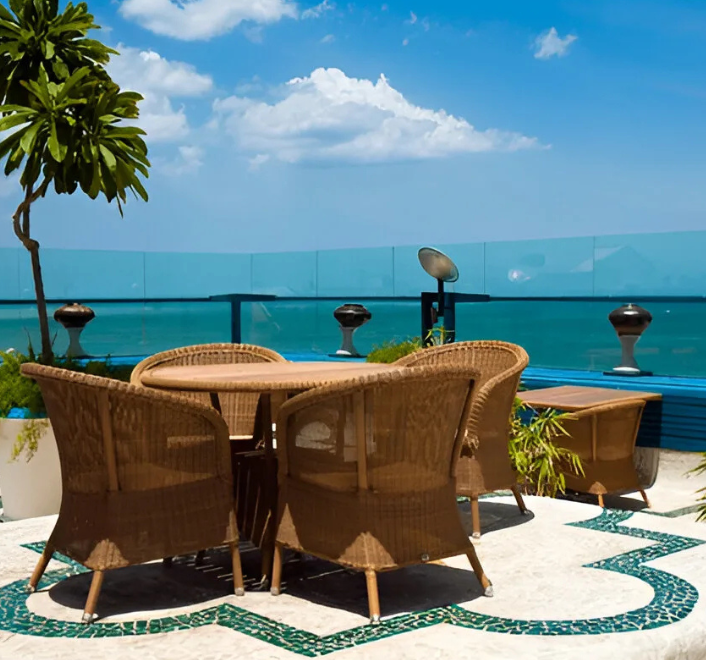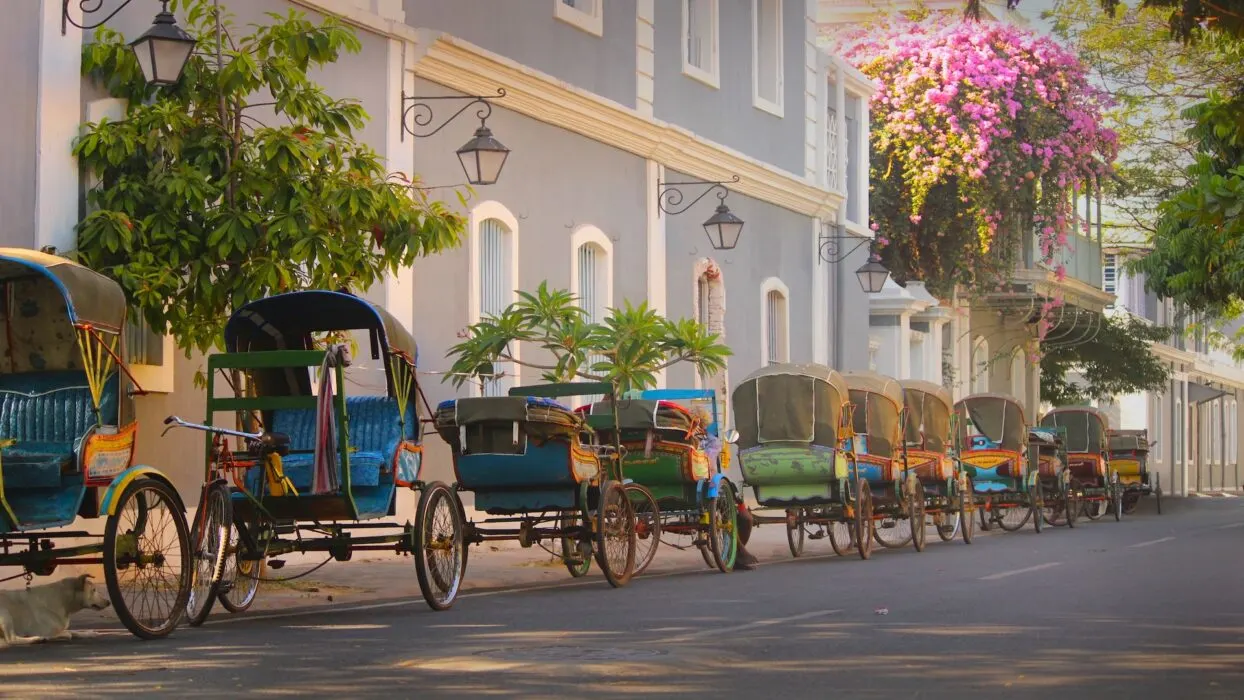Best Budget-Friendly Places to Visit in Pondicherry 2025
Pondicherry (officially Puducherry) – often called the “French Riviera of the East” – is a charming blend of colonial heritage, Indian culture, and scenic coastline. For Indian travelers on a shoestring budget, Pondicherry offers plenty of affordable (and even free) experiences. This laid-back coastal town boasts gorgeous beaches, quaint streets lined with pastel French buildings, cozy cafes, and a peaceful spiritual vibe. In fact, as one budget travel guide notes, Pondicherry is perfect for those who want to “experience Pondicherry on a budget” without burning a hole in their pocket.
In this guide, we’ll explore five of the most budget-friendly attractions in Pondicherry for 2025: Rock Beach, Sri Aurobindo Ashram, Auroville, Pondicherry Museum, and Ousteri (Oussudu) Lake. For each place, we’ll cover what makes it special, why it won’t break the bank, estimated costs, the best time to go, handy travel tips, and fun facts or anecdotes to make your trip memorable. We’ll also sprinkle in keywords like “cheap places to visit in Pondicherry,” “free things to do in Pondicherry,” and “Pondicherry travel guide for Indians” to help fellow travelers find these tips. Let’s dive in!
Places to Visit in Pondicherry
| S.No. | Places to Visit in Pondicherry | Rating |
|---|---|---|
| 1 | Auroville | 4.5 |
| 2 | Botanical Garden | 4.3 |
| 3 | Puducherry Museum | 4.4 |
| 4 | Chunnambar Boat House | 4.5 |
| 5 | Beaches | 4.3 |
| 6 | Temples and Churches | 4.5 |
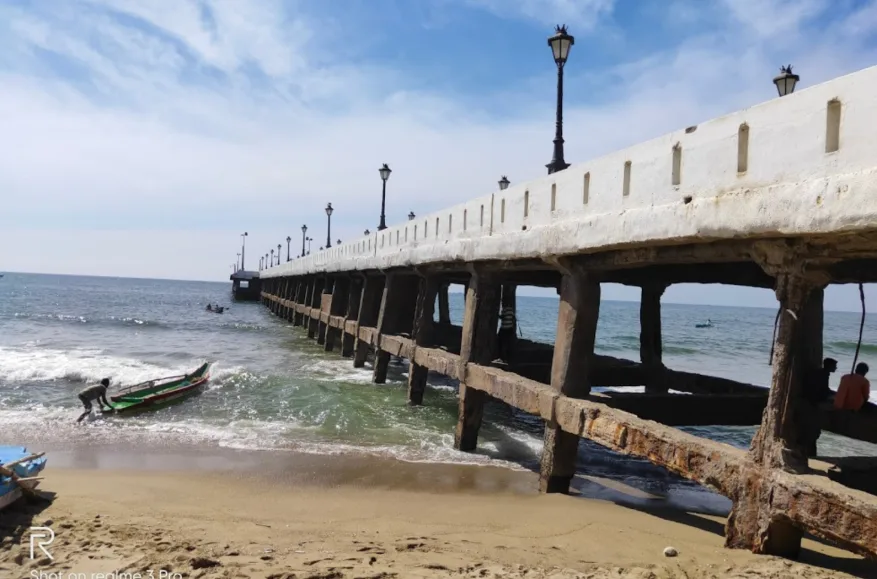
Rock Beach (Promenade Beach)
Boats and fishermen at Rock Beach (also called Promenade Beach), Pondicherry. This rocky shoreline in the French Quarter is perfect for a free, relaxing stroll.
Rock Beach (often just called the Promenade) is Pondicherry’s iconic sea-front promenade. Lined with black basalt boulders and a palm-lined footpath, it offers soothing views of the Bay of Bengal. Unlike busier spots like Paradise Beach, Rock Beach is quieter and less crowded. You can stroll for kilometers along the water’s edge, feeling the ocean breeze and admiring the quirky black rocks (they’re actually ancient volcanic boulders washed ashore). Families love watching the sunrise, and photographers flock here at sunset for the vivid sky. Because it’s right in the heart of White Town, the vibe is chill – you might spot the old lighthouse, Gandhi statue, and War Memorial nearby.
- Budget-friendly aspect: Free entry! (Just a few rupees for parking if you drive – about ₹5). Walking along the promenade costs nothing at all. Street parking is cheap, and you can always reach Rock Beach by affordable auto-rickshaw or even bicycle from almost anywhere in town.
- Estimated costs: Travel: From the main bus stand or railway station, a shared auto might cost ₹30–50. You can also rent a bicycle/scooter (~₹60–150/day) to explore the shoreline at your own pace. Entry: No entry fee (just pay a nominal parking fee, if any).
- Best time to visit: Winter months (October to February) are ideal, with pleasant 20–29°C weather. Early mornings (6–8am) and evenings (after 4pm) are especially nice for walking – the promenade opens at sunrise and extends to about 8pm. (By the way, vehicles are prohibited along the beachfront in the evening, so it’s a pedestrian-only zone for sunset walks.) Avoid mid-summer (Apr–Jun) when it can hit 40°C, and monsoon showers (Jul–Sep) can be unpredictable.
- Travel tips:
- Go for sunrise or sunset. The golden light over the waves is spectacular, and it’s cooler outside..
- Footwear: Slip-on sandals are ideal – you can kick off your shoes to feel sand underfoot, or safely perch on the rocks for photos.
- Stay hydrated & sun-safe: Carry water and sunscreen, especially on sunny days. The promenade is open-air with limited shade.
- Family-friendly, but stay vigilant: It’s a great place for kids to wander, but supervise them around the jagged rocks and waves.
- Nearby eats: White Town cafes and street-food stalls line the approach to Rock Beach – try a French patisserie or South Indian snack on your way. (Budget tip: Indian meals here can be as low as ₹100–150 per person.)
- Pair it with other sights: Rock Beach connects to Bharathi Park and the War Memorial within a few minutes’ walk. Plan to hit them in one go.
- Go for sunrise or sunset. The golden light over the waves is spectacular, and it’s cooler outside..
- Interesting fact/anecdote: The black boulders aren’t just pretty – they’re volcanic rocks that have drifted to shore. One traveler notes that sitting on the rocks here is “a great place to relax and soak in the views,” so bring a good book or camera. Locals often do yoga or jog on the promenade in the cool morning air. (And if you’re lucky, you might catch a cultural event or music performance, as this promenade hosts festivals and Bastille Day celebrations each July.)
Rock Beach is quintessential Pondicherry – breezy, free, and full of character. It’s an absolute must for any budget travel Pondicherry 2025 itinerary, since you really can’t beat the price (free!) for its beauty and central location.
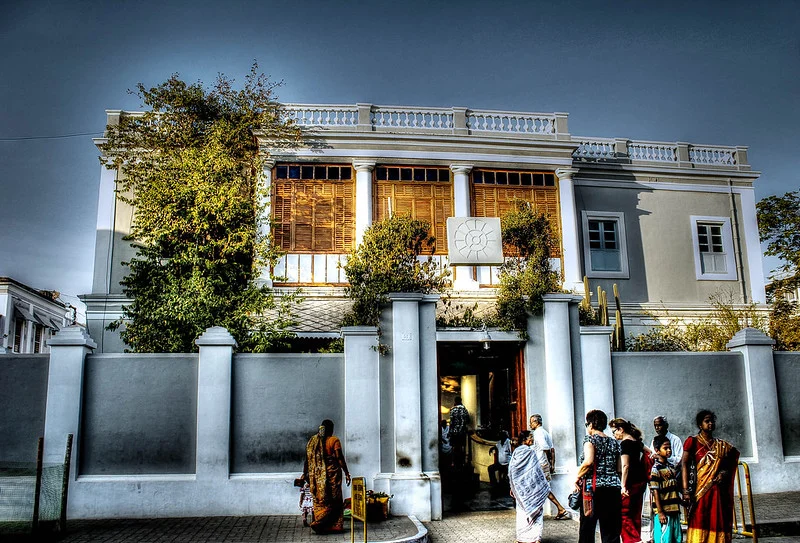
Sri Aurobindo Ashram
Sri Aurobindo Ashram is a serene spiritual retreat in Pondicherry’s White Town. Established by Sri Aurobindo (Indian freedom fighter turned yogi) and his disciple “The Mother” (Mira Alfassa), the Ashram has been a center of meditation and study since the early 20th century. The main Ashram complex is a series of courtyards, prayer halls, a library and gardens, all exuding a peaceful vibe. Many visitors come here to meditate, chant, or simply soak up the calm atmosphere under swaying trees.
- Budget-friendly aspect: Free to visit. There is no entry fee to enter the Ashram grounds. (Some inner sanctums or special sections may require a visitor pass for respectful entry, but general admittance is free.) In fact, the Ashram even runs simple dining (lunch) and gift shops, but everything is offered at very low or voluntary contribution rates.
- Estimated costs: Travel: The Ashram is centrally located – only a 5–10 minute walk from Rock Beach or the Old Light House. So if you’re already in White Town, you can simply walk or take a short cycle/auto ride (~₹20–40). Entry: ₹0 (voluntary donation, optional).
- Best time to visit: During visiting hours, typically 8:00 AM–12:00 PM and 2:00 PM–6:00 PM daily. (The Ashram advises this schedule to keep silence times, and it’s also closed for lunch and at night.) Mornings or late afternoons are best for a calm visit. It’s quietest outside of major Indian holidays.
- Travel tips:
- Dress modestly. Wear respectful clothing (no shorts or sleeveless tops for women) and remove your shoes before entering prayer halls or the Inner Chamber.
- Maintain silence. Keep your voice low or mute; photography is usually prohibited inside the main shrine. Treat it as a meditative space.
- Check timings. Observe the Ashram schedule (as above) to ensure you don’t arrive during the midday break or after closing.
- Try the Ashram canteen (optional). The Ashram Canteen offers a simple vegetarian thali meal at very low cost (often considered a donation). It’s so well-liked that even non-vegetarians rave about it. You might schedule lunch here for an authentic local experience (and a bargain meal).
- Combo with neighboring sights: Right outside the Ashram is the golden-domed Manakula Vinayagar Temple (Lord Ganesha) – a colorful Hindu temple worth a quick visit. Also, there are bookstalls and souvenirs near the Visitor Center.
- Dress modestly. Wear respectful clothing (no shorts or sleeveless tops for women) and remove your shoes before entering prayer halls or the Inner Chamber.
- Interesting fact/anecdote: The Ashram houses the Samadhi (white marble shrine) of Sri Aurobindo and The Mother – their resting places adorned with flowers. It’s a moving spiritual spot. Also, the Ashram has a famous library with some 80,000 books in 25 languages, and even hosts classical music evenings (some say Wednesdays at 8:30 PM). Many travelers find peace here: as one guide notes, visitors often say they “get lost in themselves” amid the tranquil grounds. It’s said that a short walk in the Ashram can rejuvenate the mind – perfect if your budget road trip needs a bit of soul food.
Visiting Sri Aurobindo Ashram is completely free and offers a memorable glimpse into Pondicherry’s spiritual heritage. Just remember the dress code and quiet etiquette, and you’ll have a deeply rewarding experience without spending a rupee on entry.
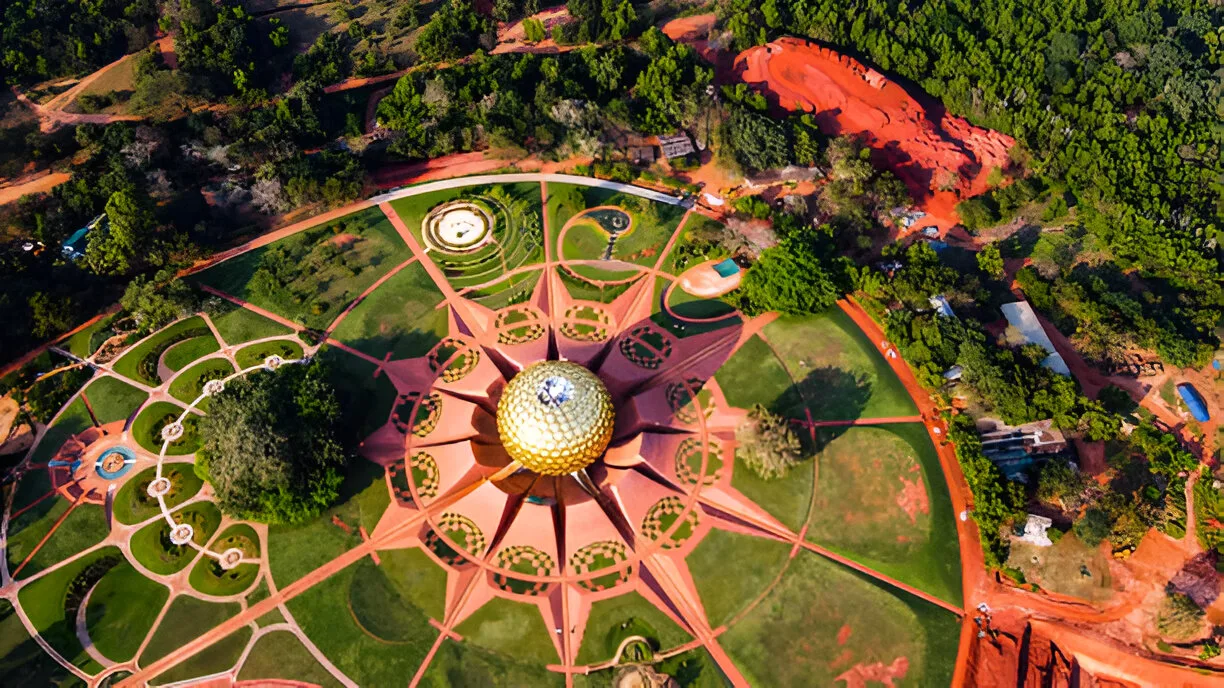
Auroville
The golden Matrimandir at Auroville, an experimental township outside Pondicherry. Entry is free and the community dining halls offer affordable meals.
Auroville is a unique international township about 12 km north of Pondicherry city. Founded in 1968 by Mirra Alfassa (“The Mother”) – a disciple of Sri Aurobindo – it was envisioned as a universal town where people of all nationalities live in harmony. The centerpiece is the Matrimandir, a striking golden globe of silence and meditation. Surrounding it are many eco-villages, solar-powered dwellings, handicraft workshops and organic farms. Walking or cycling through Auroville feels like stepping into a different world – international residents from dozens of countries coexist here in self-sufficient communes. It’s famous for promoting peace, sustainable living, and art.
- Budget-friendly aspect: No entrance fee at all – Auroville is free to visit. Even Matrimandir viewing (from outside or its official viewpoint) costs nothing. You can roam most of Auroville’s parks, playgrounds and shops without paying. (There are volunteer-run restaurants where you can pay what you can afford.) Overall it’s a perfect free/cheap half-day or full-day trip just outside the city.
- Estimated costs: Travel: From Pondicherry, the cheapest way is public transport. A local Auroville bus costs only ₹10 one-way. It will drop you a few kilometers from the Visitors Center, after which you can take a tuk-tuk (₹150 more) to reach the center, or rent a bicycle at the bus stop. Alternatively, you can hire a shared auto or rent a scooter (₹250–300/day). Entry: ₹0 (anyone can walk around for free). There is a token needed to enter the Matrimandir inner chamber, but obtaining one is also free of charge.
- Best time to visit: Cooler months (Nov–Feb) are best, like the rest of Pondicherry. Visit in the morning or late afternoon when it’s less hot. The Matrimandir grounds are open to visitors around 9:00 AM–5:30 PM, but it’s vast so even a short stroll can fill an hour. Weekdays see fewer crowds than weekends. Avoid Indian public holidays when Auroville can get busy with cultural programs.
- Travel tips:
- Start at the Visitor Centre. Every visitor should begin at the Auroville Visitor Centre (near Auroville Road). It has free exhibitions about Auroville’s history and ideals, maps, and helpful staff. You can also rent a cycle or scooter here for touring the township (cycle ~₹60/day). There are ATMs and the Solar Kitchen cafeteria too.
- Getting around: Distances are long, so bicycle or scooter is handy. Cycling is very popular (₹60 per day); it’s flat and well-shaded. The Visitor Centre even rents cycles and a “village mobility service” for tourists.
- Matri Mandir visit: If you wish to see inside the Matrimandir, you must plan ahead. Tokens can be obtained at the Visitor Centre (for free) and visits are limited in time. But even from outside or the viewing point, the golden sphere is photogenic.
- Eat cheaply: Auroville has communal canteens that serve vegetarian buffet meals at modest rates. For example, the famous Solar Kitchen lunch costs about ₹240 per person (half-price for children). There’s also a popular mixed vegetarian spread at lower cost if you have the AuroCard (a small fee). The excellent Bobbie’s & Mandi Bazaar cafeterias near the Visitor Centre serve snacks and are budget-friendly.
- Respectful behavior: Auroville encourages communal harmony. Dress casually but modestly, and be mindful that many communities here have their own simple lifestyles. Large group events (yoga, cultural) are often welcome; check notice boards for daily schedules.
- Start at the Visitor Centre. Every visitor should begin at the Auroville Visitor Centre (near Auroville Road). It has free exhibitions about Auroville’s history and ideals, maps, and helpful staff. You can also rent a cycle or scooter here for touring the township (cycle ~₹60/day). There are ATMs and the Solar Kitchen cafeteria too.
- Interesting fact/anecdote: Auroville is recognized by UNESCO and the Indian government as an experimental city. About 2,000 residents from ~50+ countries live there in tiny villages, following Sri Aurobindo’s vision of human unity. The Matrimandir’s golden globe (23m diameter) is actually covered in 12,000 sparkling golden discs! Many visitors find the atmosphere surreal – one blogger described Auroville as “the perfect place for solace seekers”. You might stumble upon organic farms, craft workshops, pottery studios, or even short meditation sessions in the open. It truly feels like stepping off the tourist trail, and the only cost of entry is your willingness to explore.
Overall, Auroville delivers a unique, almost other-worldly experience for free. It’s a must-visit if you want something very different in your Pondicherry travel guide (and a great story to tell friends about a “foreign” land within India).
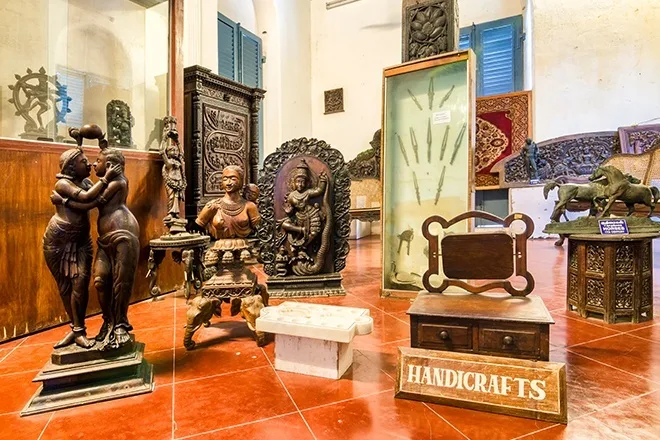
Pondicherry Museum
Pondicherry Museum is a compact historical museum tucked away on a quiet street in White Town (St. Louis Street, by Bharathi Park). Housed in an old colonial-era law court building (built 1788), it preserves artifacts that tell the story of the region: ancient Roman-trader relics, Chola and Pallava bronzes, and even colonial furniture. The museum gives a nice overview of Pondicherry’s long history – from prehistoric times through the Tamil dynasties to French colonial rule.
- Budget-friendly aspect: Very cheap entry. For Indian visitors, the museum ticket is only ₹10 (adults) or ₹5 (children). (Foreign nationals pay ₹50, so still pocket change for them.) In short, it’s a bargain way to spend an hour or two indoors learning about local heritage.
- Estimated costs: Travel: The museum is in White Town, near Bharathi Park, about 5–10 minutes by auto from the main promenade (or a short walk from Rock Beach). A local auto might cost ₹30–50. Entry: ₹10 per Indian adult, as noted.
- Best time to visit: It’s indoors, so you can go any time during the day. However, avoid Monday (the museum is closed Mondays and on national holidays). If you’re touring in the hot afternoon, the cool interior is a nice break. It’s open 9:00 AM–6:30 PM. Peak season (Oct–Feb) sees more crowds, but even then the museum is spacious enough.
- Travel tips:
- Allow ~1–2 hours. The museum isn’t huge, but it’s dense. For history buffs, allocate enough time to read the labels on the 6,500+ items.
- Look for highlights: The ground floor has three old transport exhibits (a palanquin, an antique coach, and a pousse-pousse – an early rickshaw). Upstairs are dozens of exquisite Chola bronze statues (81 in all) and Pallava carvings. Don’t miss the coins and beads from the Arikamedu excavation (evidence of Indo-Roman trade).
- Photography: Flash photography is generally not allowed (and some guards may forbid cameras altogether). So either enjoy simply viewing, or quietly snap pictures if permitted, but expect to rely on memory mostly.
- Nearby attractions: Bharathi Park (and its musical fountain) is right next door – a nice spot after the museum. The War Memorial and the Manakula Vinayagar Temple are within walking distance too. And of course, you can finish up at nearby White Town cafes or french bakeries.
- Allow ~1–2 hours. The museum isn’t huge, but it’s dense. For history buffs, allocate enough time to read the labels on the 6,500+ items.
Interesting fact: The museum’s collection was built from excavations at Arikamedu, an ancient port just outside Pondicherry where Roman merchants traded 2,000 years ago. Many of those delicate jewelry and ceramics are on display here. You’ll also see eye-catching colonial relics (like a 19th-century sedan chair used by French governors). One travel blog sums up its charm: “Pondicherry Museum preserves the true essence of South Indian history.” Indeed, for just ₹10, you get a surprising depth of history – perfect for history buffs on a budget travel Pondicherry 2025 trip.
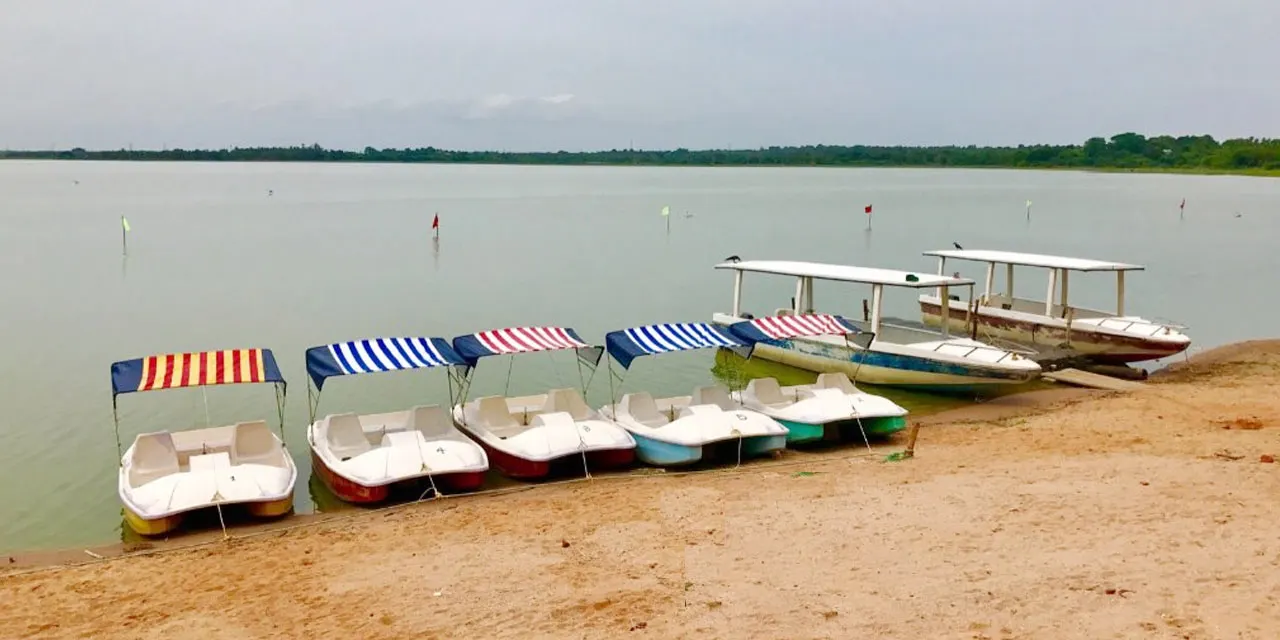
Ousteri Lake (Oussudu Lake)
Just a few kilometers southwest of Pondicherry lies the peaceful Ousteri Lake (also spelled Oussudu). This expansive freshwater lake (around 390 hectares) was originally a 20th-century irrigation project that has since become a protected bird sanctuary. Today it is one of Asia’s important wetlands and a haven for wildlife. Over 200 species of birds – including painted storks, herons, egrets and many migratory ducks – flock here, especially in winter. The surrounding marshes and islands give it a wild feel.
- Budget-friendly aspect: Largely free! Entry to the lake area (managed as the Oussudu Bird Sanctuary) is only ₹10 per person. (Students get a small concession.) That nominal fee goes to the forest department. Once inside, you can enjoy the scenery, do bird-watching, or have a picnic without spending more. The park has a simple boathouse where boating rides are available at low cost (roughly ₹100–200 for a family, varying by boat type).
- Estimated costs: Travel: Ousteri Lake is about 10–12 km from downtown Pondicherry. The cheapest way is public bus or shared auto (route buses from Pondicherry city may run here for just ₹10–20). Alternatively, auto-rickshaws can be hired (~₹50–80 each way). If you have a scooter, it’s a pleasant 20–30 min ride along rural roads. Entry: ₹10 (the gate is open 7:00 AM–5:00 PM, every day).
- Best time to visit: Early morning (6–9 AM) or late afternoon (3–5 PM) are golden. Birds are most active then, and the light is lovely on the water. Winter (November–March) is peak bird season – you’ll see painted storks, spoonbills and ducks migrating. Avoid the midday heat (July–September) and monsoon (Aug–Oct) when parts of the approach road can flood. Sunsets over the lake are also magical if you stay late.
- Travel tips:
- Bring binoculars and camera. This is a top birdwatching spot, so a zoom lens or binoculars makes it more fun.
- Wear comfy shoes. There are short nature trails and a watchtower in the park. Good walking shoes or sandals are wise.
- Food: There are no eateries inside the sanctuary, so pack snacks/water or eat in Pondicherry beforehand. Vendors do sell chai and peanuts at the entry sometimes.
- Combine with lunch: Consider timing it so you have lunch on the way back (the Ousteri area has a few simple restaurants) or stop in Murungappettai town en route for local fare.
- Stay on paths: To protect birds, stick to designated areas. Listen quietly – the call of herons and storks is part of the charm. Feeding wildlife is prohibited.
- Bring binoculars and camera. This is a top birdwatching spot, so a zoom lens or binoculars makes it more fun.
- Interesting fact: Ousteri Lake was declared a protected sanctuary in 2008 and is recognized internationally (Ramsar site) for its birdlife. Locals love it for early-morning walks and photography. An interesting anecdote: one visitor noted that the sanctuary offers the “perfect environment for birds… especially during the migratory season”. It’s truly one of the best free nature escapes near Pondicherry – you might even spot kingfishers, otters or water monitors in the jungle fringes.
Visiting Ousteri Lake is a wonderful free activity (just the small entry fee) for nature and bird lovers. If you’re looking for “free things to do in Pondicherry,” a morning here is hard to beat – it feels like a mini wilderness getaway right outside the city.
Conclusion:
Pondicherry truly shines as a budget travel destination for 2025. You can soak in its unique Franco-Tamil culture and seaside beauty without splurging. Highlights like the breezy Rock Beach promenade, the peaceful Sri Aurobindo Ashram, the utopian Auroville, the heritage museum, and the bird-filled Ousteri Lake offer world-class experiences at minimal cost. We’ve shown that with smart planning – using public transport, eating local, and focusing on free attractions – your Pondicherry trip can be both memorable and kind to your wallet. As one guide put it, Pondicherry lets you enjoy serene beaches, quaint streets and vibrant culture “all without burning a hole in [your] pocket”.
So pack your bags and set off for Pondy! With a little insider knowledge from this travel guide, even budget-conscious Indian travelers can enjoy the laissez-faire vibe and top attractions of Pondicherry. Whether you’re sipping cheap filter coffee by the promenade, exploring White Town’s alleys by cycle, or watching migratory birds at dawn, you’ll find that the Best Budget-Friendly Places to Visit in Pondicherry (2025) are literally all around you. Safe travels and happy budget adventuring in Pondicherry!
FAQs (Frequently Asked Questions)
For pleasant weather and bird migrations, visit during winter and early spring (roughly October–March). Daytime highs are comfortable (20–29°C) during this period. November–February are especially mild (15–30°C range). This is the peak tourist season, but since many activities listed here are free or cheap (like beaches, Ashram, Auroville), you can still enjoy a budget trip. Avoid summer (April–June) when it can hit 40°C, and the monsoon months (July–Sept) with unpredictable heavy rains.
A lot! Rock Beach (Promenade) is open 24/7 and has no entry fee. You can walk, jog or sunbathe there at no cost. Sri Aurobindo Ashram and its grounds have free admission (you may donate if you wish). Auroville allows free access to the Visitors Centre and most sites. Bharathi Park and the French War Memorial (near Rock Beach) are free too. The Pondicherry Museum is extremely cheap (₹10 per adult). Ousteri Lake has only a small entry fee (₹10). Even getting around can be cheap if you use local buses (some routes ₹10–20) or rent a bicycle (as low as ₹60/day in Auroville). In short, plan with these tips and your trip can be delightfully budget-friendly.
Many travelers reach Pondicherry by bus or train from nearby cities. From Chennai, the overnight train is around ₹500–600 (2nd class AC) or buses start at ₹350. Once in town, use auto-rickshaws (negotiate or insist on the meter), rent a bicycle (₹50–100/day) or take local buses. For example, the local blue Auroville bus costs only ₹10, making day trips extremely cheap. Taxis are pricier, so limit them for late nights or groups. Staying in a guesthouse or hostel in White Town can cost just ₹500–800/night in low season (and many include breakfast). Eating at local canteens or street stalls (dosas, thalis) keeps meal costs around ₹50–150. With these tricks, your daily budget can be very low.
There are plenty of enjoyable free activities: Stroll along the Promenade (Rock Beach) during sunrise or sunset. Visit Sri Aurobindo Ashram’s public grounds and gardens (quiet reflection). Explore the French Quarter on foot – snapping photos of colonial streets and churches. Attend the free sunset aarti at Sri Aurobindo Temple (every evening). Wander in Bharathi Park or along Goubert Avenue. Browse the shelves of the Ashram’s bookshop or musical CD store (free entry). Relax at the Bay of Bengal shore under casuarina trees. Even festivals like Pongal in January or Bastille Day in July offer free public events. Simply put, Pondicherry’s charm lies in experiences that cost little or nothing, which is perfect for Indian travelers watching their wallet.
Yes – while most attractions above are free or cheap, small costs can add up. Museum and sanctuary fees (₹10–50) should be planned for. Local transport and food also matter. We recommend carrying small change. Also note that Auroville guesthouses charge a fee if you stay overnight there (not relevant for a day trip). Otherwise, all the sights listed are very budget-friendly by design.
You May Also Like
Pondicherry: A Bachelor’s Beachside Getaway
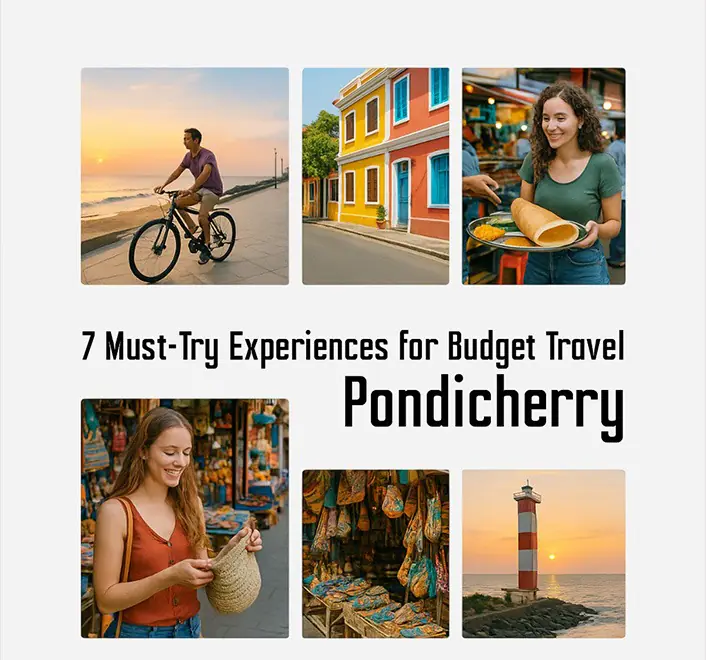
7 Must-Try Experiences for Budget Travel Pondicherry

Travel Guide to Pondicherry: Your Ultimate Checklist
